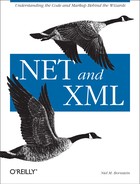Tracking Changes to a DataSet
When making changes to a
DataSet, it is often useful to keep a record of
the changes. That way you can make a set of related changes on the
client machine, then transmit just the changes back to the server.
This technique saves network time, because the changes are all
transmitted at once, and it saves bandwidth, because only the changes
are transmitted.
You could add another line of code to Example 11-8 to
see that the DataSet maintains a
“before” and
“after” view of the data. Add this
line before the Update( ) statement:
dataSet.WriteXml(Console.Out, XmlWriteMode.DiffGram);
And you’ll see the following output when you run the program:
<diffgr:diffgram xmlns:msdata="urn:schemas-microsoft-com:xml-msdata" xmlns:diffgr=
"urn:schemas-microsoft-com:xml-diffgram-v1">
<AngusHardware>
<coupons diffgr:id="coupons1" msdata:rowOrder="0" diffgr:hasChanges="modified">
<coupon_code>077GH </coupon_code>
<discount_amount>15</discount_amount>
<discount_type>0</discount_type>
<expiration_date>2002-11-09T14:17:41.6372544-05:00</expiration_date>
</coupons>
<coupons diffgr:id="coupons2" msdata:rowOrder="1">
<coupon_code>665RQ </coupon_code>
<discount_amount>15</discount_amount>
<discount_type>0</discount_type>
<expiration_date>2002-11-30T00:00:00.0000000-05:00</expiration_date>
</coupons>
<coupons diffgr:id="coupons3" msdata:rowOrder="2">
<coupon_code>81BIN </coupon_code>
<discount_amount>10</discount_amount>
<discount_type>1</discount_type>
<expiration_date>2003-01-31T00:00:00.0000000-05:00</expiration_date>
</coupons>
<coupons diffgr:id="coupons4" msdata:rowOrder="3">
<coupon_code>99GGY </coupon_code>
<discount_amount>5</discount_amount>
<discount_type>0</discount_type>
<expiration_date>2002-12-31T00:00:00.0000000-05:00</expiration_date>
</coupons>
</AngusHardware>
<diffgr:before>
<coupons diffgr:id="coupons1" msdata:rowOrder="0">
<coupon_code>077GH </coupon_code>
<discount_amount>15</discount_amount>
<discount_type>0</discount_type>
<expiration_date>2002-11-09T14:01:24.1830000-05:00</expiration_date>
</coupons>
</diffgr:before>
</diffgr:diffgram>This is the DiffGram, and it shows the current
state (“after”) of the data in the
DataSet, as well as a
“before” state in the
diffgr:before element.
The DiffGram is an XML
document that has three sections. The first, the current data
instance, is represented by an XML element whose name matches the
DataSet name; in this case,
that’s the AngusHardware element.
Under the data instance element, the current state of each row in
each of the DataSet’s
DataTables is serialized as a simple XML element.
The second section,
diffgr:before, lists the values of any rows that
have changed before the change. And the third section,
diffgr:errors, shows any errors that occurred
during the generation of the DiffGram.
Example 11-9 shows the general format of the
DiffGram.
<diffgr:diffgram xmlns:msdata="urn:schemas-microsoft-com:xml-msdata" xmlns:diffgr= "urn:schemas-microsoft-com:xml-diffgram-v1"> <DataSetName> <DataTableNamediffgr:id="DataTableName1" msdata:rowOrder="0" diffgr:hasChanges="modified"> <DataColumnName>DataColumnValue</DataColumnName> <DataColumnName>DataColumnValue</DataColumnName> ... </DataTableName> <DataTableNamediffgr:id="DataTableName2" msdata:rowOrder="1"> <DataColumnName>DataColumnValue</DataColumnName> <DataColumnName>DataColumnValue</DataColumnName> ... </DataTableName> </DataSetName> <diffgr:before> <DataTableNamediffgr:id="DataTableNamen" msdata:rowOrder="DataRown"> <DataColumnName>DataColumnValue</DataColumnName> <DataColumnName>DataColumnValue</DataColumnName> ... </DataTableName> ... </diffgr:before> <diffgr:errors> <DataTableNamediffgr:id="DataTableNamen" diffgr:Error="ErrorText"/> ... </diffgr:errors> </diffgr:diffgram>
The
following details the DiffGram elements,
attributes, and content:
-
diffgr:diffgram This is the root element of the
DiffGram. It uses two namespaces, prefixed withmsdataanddiffgr, respectively.-
DataSetName This element’s name is the name of the
DataSet. All the current values of eachDataTable’sDataRows are included within this element.-
DataTableName This element’s name is the name of the
DataTable, and the element represents an individualDataRow.-
DataColumnName This element represents a
DataColumnwithin a singleDataRow. Its content is the current value of the column for that row.-
diffgr:before This is the element that contains the previous values of any changed
DataRows. Its content represents the previous value of aDataRowinstance with the matching value of theDataTableName’sdiffgr:idattribute.-
diffgr:errors This is the element that contains any error messages. Its
diffgr:Errorattribute contains the error message for theDataRowinstance with the matching value of theDataTableName’sdiffgr:idattribute.-
diffgr:id This attribute represents a unique identifier for a
DataRow. Its content is made up of theDataTablename and a sequential number. It is used to map the current value of aDataRowto the previous value in thediffgr:beforesection or to any errors in thediffgr:errorssection.-
msdata:rowOrder This attribute indicates the order of the
DataRowwithin theDataTable.-
diffgr:hasChanges This attribute is used to indicate whether the current value of a
DataRowrepresents any changes, in which case the previous values will be listed in thediffgr:beforesection.diffgr:hasChangescan have the valueinserted,modified, ordescent:-
inserted The value
insertedidentifies an element which has been added-
modified The value
modifiedidentifies an element that has been modified-
descent The value
descentidentifies an element where one or more children from a parent-child relationship have been modified-
diffgr:Error This attribute’s content is a textual error message describing an error that arose while attempting to change the data in a
DataSet.
Although the DiffGram is used internally by .NET
for remoting and web services, it can also be used by any external
system that needs to communicate database changes to a .NET
DataSet.
